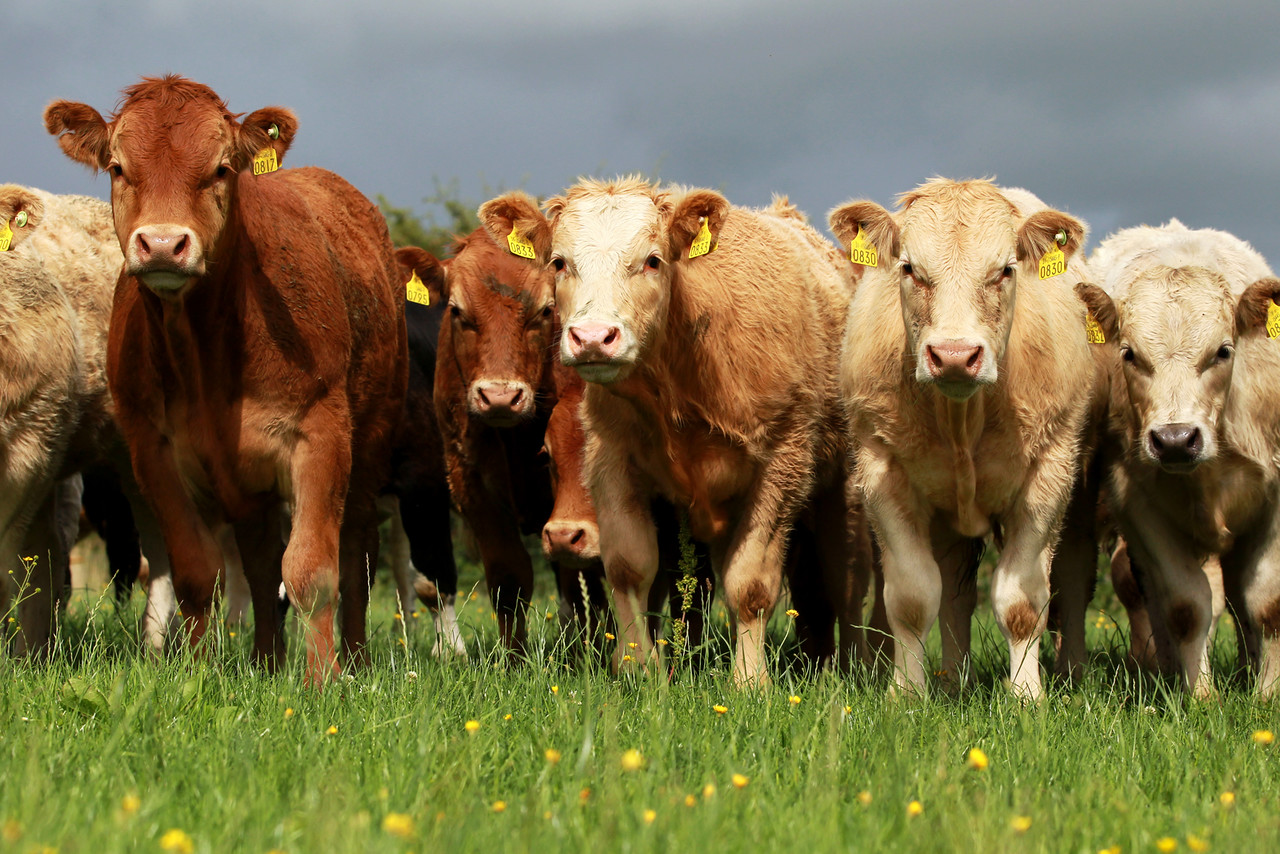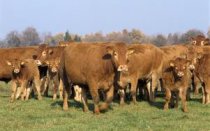
Clostridial Disease
A page about clostridial diseases in cattle including blackleg, pulpy kidney, braxy, tetanus, malignant oedema, black disease and infections with Clostridium perfringens or Clostridium sordellii.

Introduction
Clostridia are the oldest known disease causing agent (pathogen) affecting livestock and other species. They are not contagious but are highly infectious and are ubiquitous worldwide.
Aetiology
There are a large number of syndromes associated with clostridial disease in cattle and sheep, each with distinct risk factors, clinical signs and control. The common disease syndromes are listed below:
Blackleg
Bacterial spores are found in soil and enter the animal via the oral route. They lodge in the spleen, liver and intestine of normal animals. Subsequently they proliferate under some unknown stimulus and cause disease. Animals at risk are mainly cattle between 6 months and 2 years that are rapidly growing on a high nutrition plane. Disease can sometimes occur in sheep. It is a gangrenous disease of muscle and can be caused by a variety of clostridia as follows:
- “True” blackleg = Cl. chauvoei
- “False” blackleg = Cl. septicum and Cl. novyi
- Often see the three clostridia in combination
Clinical signs include sudden onset of lameness, high fever and animals are very depressed. They often have a swollen limb which is initially warm but then becomes cold. Death follows in 12 to 36 hours though animals are often just found dead. A post mortem examination can confirm it as cause of death. At post mortem examination affected tissue will have a characteristic dark purple colour and a rancid odour. Oedema, and gas or emphysema may be present also.
Pulpy Kidney
Pulpy kidney is mainly a disease of sheep caused by C. perfringens type D. The bacterium is normally found in the intestinal tract. It proliferates in animals up to 2 years of age. While it mainly affects lambs, calves, sheep and goats may also be affected. Adult cattle are seldom affected. Over eating, starchy diets and dietary change have been identified as risk factors.
Clinical signs often involve sudden death. If found alive, animals may show neurological signs and depression.
Kidney decomposition while commonly found in diseased animals may also be found in animals which die of other causes, particularly in sheep, as kidneys rapidly autolyse due to normal post mortem degeneration.
Braxy
Caused by C. septicum, which is normally found in gut and soil, this organism can proliferate particularly in animals fed autumn forage crops or roots that have been frosted. Disease is suspected to be due to frost damage to the lining of the abomasum (fourth stomach) which allows the organism to grow and produce toxin. Clinical signs include sudden death or severe depression if found alive.
Tetanus
This organism, C. tetani is found in soil and manure. When it is taken in by infecting a deep wound or (rarely) orally, it can proliferate and produces a potent toxin affecting the nervous system. Variable species sensitivity exists with horses the most sensitive and cattle the least. Examples of common entry points include via deep puncture wounds, sole punctures, parturition tears, post castration and docking and after the use of elastrators. Disease is usually sporadic and outbreaks are rare.
Clinically tetanus is characterized by hyperaesthesia (they over-react to touch), prolapsed 3rd eyelid, restricted jaw movement, tetany (muscle rigidity) and ultimately convulsions. Clinical signs of tetanus may not appear for days or weeks following tissue inoculation. Affected animals will demonstrate muscle stiffness that progress to tremors and a stiff gait. A saw horse stance may develop and animals may fall and be unable to rise. Cattle will typically develop bloat and can die in five to ten days if left untreated. Animals often die due to asphyxia. Clinical pathology testing and necropsy will seldom yield a definitive diagnosis. The incubation time can be days to weeks.
Malignant Oedema
Caused by C. septicum (or occasionally C. chauvoei) which is found in gut and soil, this disease results from contamination of tissues due to deep penetrating wounds becoming infected with this bacterium. The organism proliferates in poorly perfused damaged tissue and elicits toxins which cause mortality – the animal is often just found dead. On post mortem examination tissues may be oedematous, with emphysema, malodour and swelling obvious.
Black Disease
This disease affects young adult sheep or occasionally cattle usually aged 1 to 4 years. Once taken in orally the organism lodges and waits in liver. Liver damage, caused by immature fluke tracking through, initiate disease.
Clinical Signs include stiffness, severe depression and sudden death. It most often occurs in acute fluke season though can occur sporadically at other times, especially in cattle. Clinical disease lasts 1 or 2 days and findings on post mortem examination include rapid putrefaction of carcass with black discoloration under the skin.
Clostridium perfringens infections
Infections with C. perfringens Types A, B, C or D can lead to enteric effects in animals. The organisms are usually found in the soil and intestinal tract and can proliferate in times of sudden dietary change. Clinical signs are most commonly of sudden death, though affected animals may show severe diarrhoea or gas gangrene of tissues prior to death. Outbreaks can occur. Characteristic pathology on post mortem examination include haemorrhagic enteritis, intestinal mucosal ulceration, diarrhoea contents in the intestines and evidence of dysentery. Affected animals are usually young.
Clostridium sordellii infections
Infections with C. sordellii can lead to enteric or muscle disease in animals. The organisms are usually found in the soil and intestinal tract and can proliferate in times of sudden dietary change or due to physical muscle trauma. Clinical signs are most commonly of sudden death, though affected animals may show severe diarrhoea or gas gangrene of muscle (Blackleg) with depression prior to death one to two days later. Outbreaks can occur. Characteristic pathology on post mortem examination include haemorrhagic enteritis, intestinal mucosal ulceration, diarrhoea contents in the intestines, muscle damage (Blackleg) and evidence of dysentery. Affected animals are usually older than 3 months.
Clostridium haemolyticum infection
Infections with C. haemolyticum (C. novyi Type D) can lead to systemic effects mainly in cattle (though rarely in sheep and very rarely in dogs) and haemoglobinuria. The organisms are usually found in the soil and intestines in certain regions of Ireland e.g. Limerick / Tipperary and lodges in the liver. Liver fluke may be a trigger for proliferation. Clinical signs are most commonly of sudden death, though affected animals may show abdominal pain, dysentery, variable levels of jaundice/anaemia and haemoglobinuria prior to death. Outbreaks can occur. Characteristic pathology on post mortem examination include haemoglobinuria and icterus. Affected animals are usually adult.

Epidemiology
The main source of clostridia is spores in soil and regional differences in husbandry practices can affect incidence of disease. The organisms are highly infectious but not contagious. After replication in the target organ, disease is often characterised by sudden death. The factors that influence disease occurrence depend on the species of clostridia involved. They may be ingested with feed and water and consequently healthy robust animals are often the first victims. The organisms are often present in organs or tissues of healthy animals and become pathogenic only after primary factors cause changes in habitat. Examples of such primary factors include accidental injury, husbandry procedures, fighting, liver fluke infestation, overeating (too much starch) etc. It is advisable to look under each disease entity as epidemiology can differ for each.
Clinical Signs
Clinical signs are influenced by the age of the animal, the dose of clostridia, route of infection and whether other agents are also present. It is advisable to look under each disease entity as clinical signs can differ for each.
Diagnosis
Clinical signs of specific clostridial diseases are only suggestive of clostridial infection but laboratory tests and post mortem examination of a freshly dead animal are required for a definitive diagnosis.
Post-mortem Examination
It is only useful to submit animals to the laboratory for investigation if they are freshly dead or dying. Clostridia have a real capability of multiplying in carcases post mortem which can interfere with an accurate diagnosis. Certain pathologies are highly suggestive of some of the clostridial disease syndromes. It is advisable to look under each disease entity as a brief description of PM findings are given for each.
Control
Control of clostridial disease is based on a number of disease-specific and important aspects:
- Vaccination – The use of inactivated vaccines tailored to the risk profile of the animal group is preferred.
- It is advisable to look under each disease entity as a brief description of the disease-syndrome-specific control options are given for each.
Vaccination
Important general aspects of clostridial vaccination include the following:
- Primary course – A primary course of two doses is generally required with 4-6 weeks between doses. If the second dose is not administered, full immunity will not be achieved.
- Young animals – Timing of vaccination may be influenced by whether the dam is vaccinated or not. Check the exact timing of vaccination as this differs depending on the vaccine and maternal immune status.
- High risk of infection – Occasionally vaccines may have to be administered more frequently to cater for specific disease syndromes where infection pressure is high or other risk factors exist
For more information on vaccination see below.
Clostridial Vaccines
MSD Animal Health currently market the following clostridial vaccines:
Tribovax T – For use in cattle and sheep.
Tribovax 10 (Known as Bravoxin 10 in NI)- For use in cattle and sheep. For more information on the use of this vaccine in Northern Ireland click here and for Republic of Ireland click here. For summary of product characteristics please click here.
Combined clostridial and pasteurella (M. haemolytica) vaccines are marketed for sheep and include:
Ovivac P Plus – For use in store lambs.
Heptavac P Plus – For use in breeding replacement lambs and adult breeding animals.
